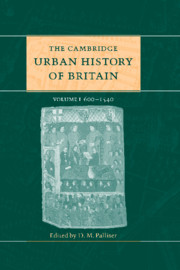Book contents
- Frontmatter
- Part I Introductory
- Part II The early middle ages 600–1300
- 3 General survey 600–1300
- 4 Power and authority 600–1300
- 5 Society and population 600–1300
- 6 The economy of British towns 600–1300
- 7 Churches, education and literacy in towns 600–1300
- 8 The topography of towns 600–1300
- 9 London from the post-Roman period to 1300
- 10 The large towns 600–1300
- 11 Small towns 600–1270
- Part III The later middle ages 1300–1540
- Part IV Regional surveys
- Part V Conclusion
- Appendix: Ranking lists of English medieval towns
- Select bibliography
- Index
- References
3 - General survey 600–1300
from Part II - The early middle ages 600–1300
Published online by Cambridge University Press: 28 March 2008
- Frontmatter
- Part I Introductory
- Part II The early middle ages 600–1300
- 3 General survey 600–1300
- 4 Power and authority 600–1300
- 5 Society and population 600–1300
- 6 The economy of British towns 600–1300
- 7 Churches, education and literacy in towns 600–1300
- 8 The topography of towns 600–1300
- 9 London from the post-Roman period to 1300
- 10 The large towns 600–1300
- 11 Small towns 600–1270
- Part III The later middle ages 1300–1540
- Part IV Regional surveys
- Part V Conclusion
- Appendix: Ranking lists of English medieval towns
- Select bibliography
- Index
- References
Summary
For most of the period under review the data allow a qualitative, rather than a quantitative, approach to towns and, therefore, important issues such as the relative size of towns can be addressed only in an oblique fashion. From the late tenth century an indication of the relative intensity of urban development can be gained from, first, the coin evidence and, then, Domesday Book, followed by the taxation records. While the documentary record increases from the twelfth century, it is largely ‘external’ to the town itself and reflects the growth and interests of central government; historical evidence is, therefore, mainly concerned with the process of creating and administering towns. A major exception are the urban surveys which survive for a small number of towns and start in the later thirteenth century.
Much new information has come from archaeological fieldwork, but this, like the documentary material, has a bias towards the larger towns. The proportion of any town that has been excavated is very small, and consequently it is difficult to assess the validity of the sample. Excavated evidence can show the diversity of a town through information about the urban fabric, including communal structures such as defences and churches, as well as domestic and industrial buildings, and about the inhabitants themselves and the kind of environment they lived in. Where it is possible to draw upon the results of a number of archaeological excavations in the same town, aspects of the urban economy can be discussed, such as the range and organisation of industries and trading patterns.
- Type
- Chapter
- Information
- The Cambridge Urban History of Britain , pp. 25 - 50Publisher: Cambridge University PressPrint publication year: 2000
References
- 5
- Cited by

